|
| What are the Symptoms of Tennis ElbowTennis Elbow - SymptomsThe onset of tennis elbow pain is normally gradual with tenderness or a dull ache felt in the tendons of your forearm muscles on or below the bony bumps of your elbow. Pain can also be experienced when your wrist or hand are straightened, when your palms are facing the ceiling, when you flex your wrist and fingers backwards while straightening your elbow, or when you rest your wrists on a tabletop or desk. 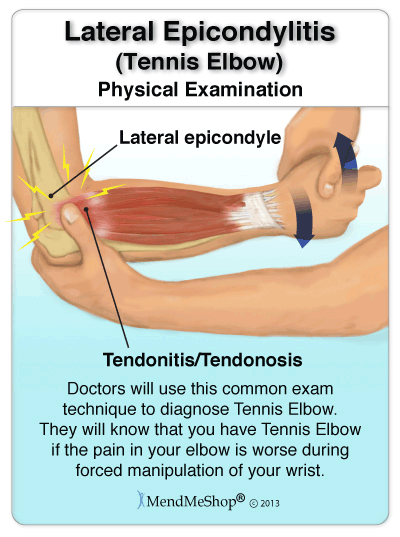 Are you noticing pain, discomfort, immobility or restricted motion in your elbow or forearm? Do these symptoms appear before, during, or after you exercise, do daily household duties, or at work? These symptoms could be the first sign that you are suffering from Tennis Elbow. You may notice swelling, heat or redness, inability to lift or carry objects, inflexibility, deformation, bruising, or pain caused by movement or that persists even through rest. If you have tennis elbow, you will feel pain or discomfort when performing repetitive movements such as grasping, carrying objects (a tray, a baby or books), or twisting with your hands or wrists. If you do not seek treatment in the form of warming and cooling temperature treatments for your symptoms and you are suffering from Tennis Elbow, you may develop a chronic Tennis Elbow injury due to overuse or even re-injury. Chronic symptoms can include pain before, after, and during activities that does not go away as well as limited range of motion and inflexibility that will interrupt your daily life. Straightening your wrist or hand, or turning your palms to face the ceiling may cause severe discomfort. Extending and flexing your fingers or lifting everyday objects can trigger Tennis Elbow pain. These symptoms may require you to change, or completely stop, movements using your arm or hand. 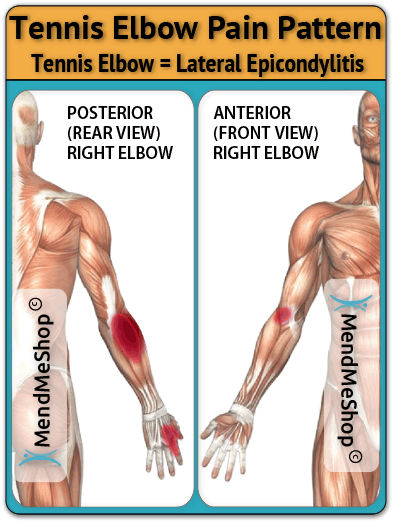 In severe cases, turning a screwdriver or even holding a coffee cup can cause intense discomfort. It is easy to forget how much you use your hands and arms on a daily basis. When you are suffering from Tennis Elbow, even the most simple tasks can become quite a challenge! Imagine having to take weeks or even months off work, or missing a whole season of your favorite sport or activity. The burden that an untreated Tennis Elbow injury can place on your finances, your family, and your quality of life, can be heavy. Tennis Elbow pain normally starts with tenderness or a dull ache around the bony bumps on the outside of your elbow. These bumps are also known as your lateral epicondyle bone. It is here, that the tendon for the muscle in your forearm, attaches to the bone. If left untreated, the pain may gradually start to radiate, from the outside of your elbow, extending down into your forearm and wrist. Typically tennis elbow starts off as acute, or short lived pain that goes away after about 24 hrs. Tennis Elbow Pain Scale Acute to Chronic PainOnset of symptoms, such as soreness, may not appear immediately after an activity. If you begin to notice discomfort 24-72 hours after doing an activity, it could be an indication that tiny tears have started to form in your tendon. When the body experiences sensations of pain or discomfort, it is trying to tell you that something is wrong. By ignoring your body's warning signs, you could be putting yourself at risk of developing a chronic injury. Why Is It Important To Treat My Symptoms?Symptoms of Tennis Elbow are not the same for everyone. You may experience only one symptom or perhaps a combination of symptoms. The severity of these symptoms can differ from person to person.  Sometimes, a person suffering from Bi-lateral Tennis Elbow (that's both elbows at once ) will have different symptoms for each elbow. This is because no two injuries are exactly the same. You may notice slight discomfort in your elbow, that disappears after a few hours or up to a day later. If you are relying on short periods of rest or use Non-Steroidal Anti-Inflammatory Drugs (NSAIDs) to mask the pain of your injury, you are not giving your body the proper attention it needs to recover. In fact, by masking your symptoms of pain, immobility, and discomfort, you are blocking out the warning signs your body is using to tell you something is wrong! By hiding your Tennis Elbow symptoms you are putting yourself at risk for damaging your elbow permanently. While some symptoms can occur suddenly (as with an accident or acute trauma), Tennis Elbow is most often a case of gradual overuse. If not given proper attention, repetitive stress and re-injury will develop into a Chronic Tennis Elbow Injury.  It is important to remember that pain is not the only indication of a serious injury. The micro tears, scarring, and inflammation which are the underlying causes of Tennis Elbow can occur even if pain is not noticeable or is relieved quickly. Injuries due to repetitive movement are most often caused by this common misunderstanding. Short term pain relief such as rest, elevation, and medication will not promote long term healing! Being proactive is the best way to fight Tennis Elbow. Stop the pain and damage before it causes further injury requiring months, or even years of your life spent in recovery. The information you will discover here will help you manage your Tennis Elbow symptoms as soon as possible. The Elbow TShellz Wrap® is intended to be used as a vital part of a conservative treatment protocol for people recovering from elbow, forearm, upper arm or general elbow injuries - such as muscle tears, tendon tears, strains, tendonitis, tendinopathy, tendinosis, impingements, elbow bursitis, and any pain associated with trigger points, scar tissue, and arthritis in the arm, elbow or forearm. When Should I Seek Medical Attention?You should always consult your doctor when you begin to experience recurring pain or symptoms of Tennis Elbow injury. It is essential to speak with a medical professional if you have started, regularly taking, "over the counter" medications to treat your symptoms. We always recommend that you speak with your physician to confirm the nature and severity of your elbow injury. Continued discomfort in your elbow should be investigated, as it can lead to long term damage. If you experience any of the symptoms below then talk to your physician and see if our conservative treatments are right for you. If you are experiencing any of the following symptoms, you should speak with your physician as soon as possible. Common Symptoms of Lateral Epicondylitis (Tennis Elbow) are as follows:
A proper diagnosis from your physician is the only way to know for sure that you are suffering from Tennis Elbow. A visit to your doctor can rule out any other conditions that may be causing your symptoms such as, injury to the shoulder, arthritis, or bursitis. Speaking to your physician will help you understand the best course of action to treat your symptoms. Depending on the how much pain you are in and how long you have had symptoms, your physician will most likely recommend a program of conservative treatments which incorporate cooling and heating treatments. Through the use of an Elbow TShellz Wrap®, you can greatly reduce your chances of developing long term damage and return to living, pain free, as soon as possible! To look into conservative treatment options for soft tissue injuries in the elbow and forearm, please go to our tennis elbow treatments page. Product Advisors are available 9:00 am to 5:00 pm Eastern Standard Time Monday to Friday. Learn More About Elbow Injuries & TreatmentsI want to learn more about TShellz Wrap® Circulatory Boost I want to learn more about Ice & Heat: Which Is Better For Treatment? I want to learn How To Get Rid of Tennis Elbow I want to learn How To Get Rid of Golfers Elbow I want to learn more about Elbow Anatomy I want to learn more about Elbow Surgery I want to learn more about Elbow Post-Surgery Recovery During your recovery, you will probably have to modify and/or eliminate any activities that cause pain or discomfort at the location of your soft tissue injury until the pain and inflammation settle. Always consult your doctor and/or Physical Therapist before using any of our outstanding products, to make sure they are right for you and your condition. The more diligent you are with your treatment and rehabilitation, the faster you will see successful results! |
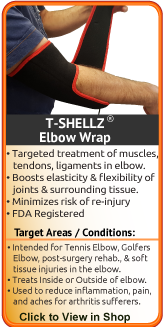   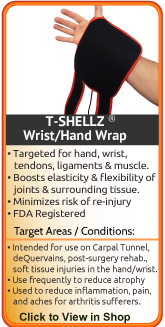  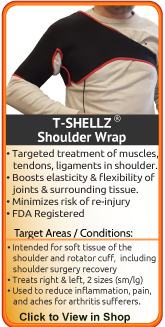   |




